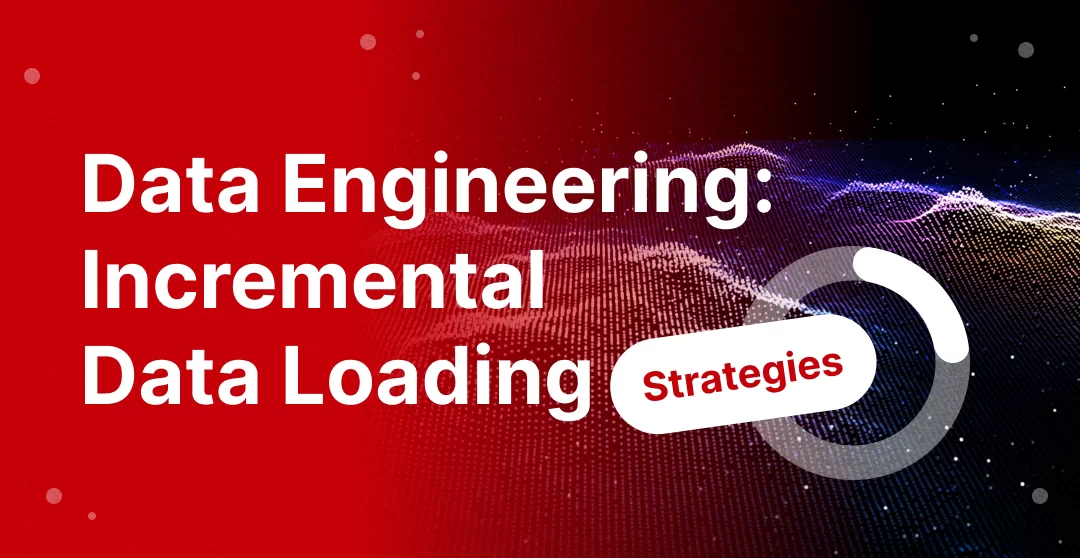Data Engineering: Incremental Data Loading Strategies
 Christopher Garzon
Christopher Garzon
Incremental data loading is an approach to data integration that transfers only the new or changed records from one database or data source to another, rather than moving the entire data set. This method is especially beneficial in environments where data changes frequently and data volumes are large, as it significantly reduces the amount of data that must be processed and transferred during each update cycle.
Because incremental loading techniques focus on changes to data over time, they rely on identifying changes through various mechanisms, such as timestamps, change data capture (CDC) systems, transaction logs, or database snapshots. Each technique provides a unique method for distinguishing and extracting only the data that has changed or been added since the last load, enabling more efficient data synchronization processes.
In practice, the implementation of incremental data loading strategies often uses a combination of specialized tools and custom scripts. Tools such as Apache NiFi, Talend, and Informatica PowerCenter, among others, provide built-in support for various incremental loading techniques, making it easy to automate data pipelines and ensure efficient, reliable data flows.
In this article, we will review the technicalities, challenges, and solutions associated with incremental data loading, to equip practitioners with the knowledge to navigate this critical aspect of data engineering.
Strategies for Incremental Data Loading
Implementing incremental data loading involves selecting a strategy that best suits the specific characteristics of the data and the operational requirements of the system. Below, we explore several strategies for incremental data loading, discuss their technical implementation, and provide code snippets to demonstrate their application.
Timestamp-based incremental loading
This strategy relies on timestamp fields in the data source, identifying new or updated records based on the last time the data was loaded.
Technical Implementation: Add a timestamp column to each record in the source database. During each load process, query for records with timestamps greater than the last successful load time.
Code Snippet:
SELECT * FROM source_table
WHERE last_modified_timestamp > '2024-01-01T12:00:00';
Change data capture (CDC) method
CDC involves tracking and capturing changes in data at the source system, ensuring that insertions, updates, and deletions are all accurately replicated in the target system.
Technical Implementation: Enable CDC on the database or use a tool like Debezium with Kafka to capture and stream database changes.
Code Snippet (Debezium Configuration):
{
"name": "inventory-connector",
"config": {
"connector.class": "io.debezium.connector.postgresql.PostgresConnector",
"database.hostname": "localhost",
"database.port": "5432",
"database.user": "dbuser",
"database.password": "dbpassword",
"database.dbname" : "inventory",
"table.include.list": "public.customers",
"plugin.name": "pgoutput"
}
}
Log-based incremental loading
Leveraging transaction logs maintained by the database, this strategy extracts change data by analyzing these logs, offering a detailed record of all transactions.
Technical Implementation: Access and parse the database’s transaction log. Implement a process to filter and extract relevant change data since the last extraction.
Code Snippet: Due to the proprietary nature of database logs and the complexity of direct log parsing, log-based incremental loading is often handled by specialized tools or database features rather than custom code.
Snapshot-based incremental loading
Snapshots capture the state of a database at a particular moment in time. By comparing consecutive snapshots, changes can be identified and loaded.
Technical Implementation: Regularly create database snapshots. Compare the current snapshot with the previous one to detect changes.
Code Snippet (Pseudo-code):
previous_snapshot = load_previous_snapshot()
current_snapshot = create_current_snapshot()
changed_records = compare_snapshots(previous_snapshot, current_snapshot)
Each incremental load strategy has its own advantages and considerations. The choice of strategy should be based on factors such as the nature of the source data, the capabilities of the source system, performance requirements, and the specific operational context of the data pipeline.
Tools and Technologies Supporting Incremental Loading
These tools offer built-in support for various incremental loading techniques, simplifying the data integration process and ensuring efficient, reliable data flows.
Apache NiFi excels in managing data flows that require incremental loading through its processor components. Processors such as QueryDatabaseTable can be configured to track state across executions, effectively supporting incremental data extraction based on specific column values.
Talend supports incremental loading through components like tMySQLInput and tMSSqlInput, which can be configured to query data based on timestamps or other changing conditions. Its graphical interface simplifies the design of incremental loading processes, making complex integrations more accessible.
Informatica PowerCenter supports incremental loading through its CDC solutions and transformation components, enabling users to capture and integrate only the changed data. It provides a comprehensive set of tools for managing CDC logic, including log-based and trigger-based CDC.
Debezium is particularly suited for CDC-based incremental loading strategies. It integrates with Apache Kafka to provide a scalable and reliable method of capturing and streaming data changes, making it ideal for scenarios that require real-time data synchronization.
Implementing Incremental Data Loading
Breakdown of the technical steps involved in setting up an incremental data loading process tailored to modern data ecosystems.
Step 1: Define data sources and targets
Begin by cataloging your data sources and targets. This involves identifying the databases, APIs, and file systems from which data will be extracted and where it will be loaded. Understanding the nature of these sources and targets — such as the data formats they support and their access mechanisms—is crucial for designing an effective incremental loading solution.
Step 2: Select an incremental loading strategy
Based on the characteristics of your data and the capabilities of your data sources, choose a suitable incremental loading strategy. For databases that support Change Data Capture (CDC), a log-based approach may be optimal. Alternatively, for sources where CDC is not available, timestamp-based or snapshot-based methods can be employed. The strategy should align with your data velocity and volume, as well as the freshness requirements of your data targets.
Step 3: Implement data extraction logic
Develop the logic for extracting data changes from your sources. This could involve writing SQL queries that select records based on a last-modified timestamp or configuring a CDC tool like Debezium to capture changes from database logs.
-- Example of a timestamp-based extraction query
SELECT * FROM orders WHERE last_updated > LAST_EXTRACT_TIMESTAMP;
For CDC with Debezium, you would configure connectors to monitor your source databases and stream changes to a Kafka topic.
Step 4: Design the data transformation and loading process
Plan how the extracted data will be transformed and loaded into the target system. This may require designing ETL pipelines that clean, enrich, and reformat data to fit the schema of the target datastore. Using an ETL tool like Apache NiFi or Talend, you can visually map out these transformation steps and configure them to run incrementally.
Step 5: Handle state management
To ensure that each incremental load picks up precisely where the last one left off, implement state management mechanisms. This could be as simple as storing the timestamp of the last successful extract in a file or database table, or more complex state tracking within a tool like Apache NiFi, which manages state automatically for certain processors.
Step 6: Ensure data quality
Incorporate data validation and cleansing steps within your pipelines to maintain high data quality. This might involve removing duplicates, standardizing formats, and performing sanity checks to catch anomalies that could indicate extraction issues.
Step 7: Automate and schedule the loading process
Use workflow scheduling tools such as Apache Airflow to automate the execution of your incremental data loading pipelines. Define schedules that align with your data freshness requirements and operational windows.
# Example of scheduling an incremental load pipeline in Apache Airflow
from airflow import DAG
from airflow.operators.python_operator import PythonOperator
from datetime import datetime, timedelta
default_args = {
'owner': 'data_engineer',
'depends_on_past': False,
'start_date': datetime(2024, 1, 1),
'email_on_failure': False,
'email_on_retry': False,
'retries': 1,
'retry_delay': timedelta(minutes=5),
}
dag = DAG('incremental_load', default_args=default_args, schedule_interval=timedelta(hours=1))
def load_task():
# Logic to execute load process
load = PythonOperator(task_id='run_load', python_callable=load_task, dag=dag)
After deployment, continuously monitor the performance of your incremental loading processes. Look for bottlenecks, failed loads, and data quality issues. Use insights from this monitoring to refine and optimize your pipelines, adjusting strategies and configurations as needed.
Subscribe to my newsletter
Read articles from Christopher Garzon directly inside your inbox. Subscribe to the newsletter, and don't miss out.
Written by

Christopher Garzon
Christopher Garzon
The goal of data engineer academy is to help people do two things. Learn the skills needed to be in data related roles and learn how to ace the interviews as well. We believe data related roles are in the early phases of their growth. And in addition to learning the skills, learning how to pass the interviews are just as important and our goal is to create clarity when it comes to both of those skillets.